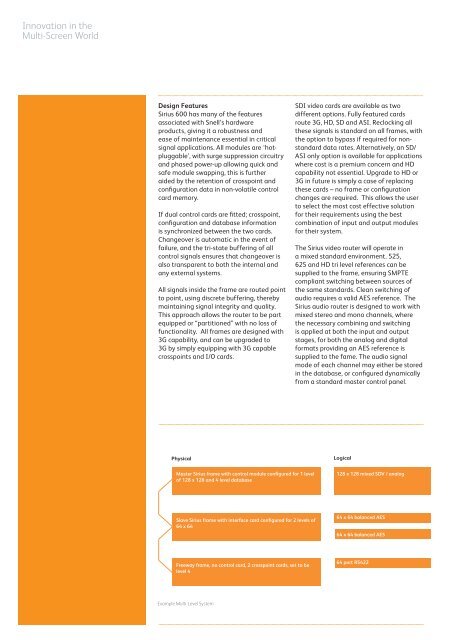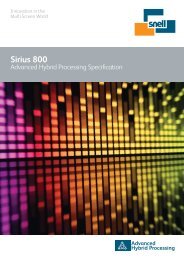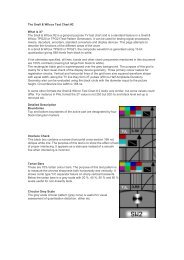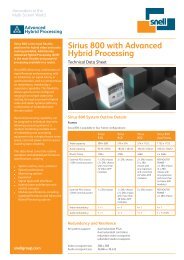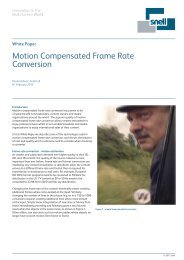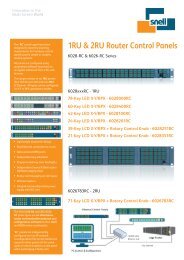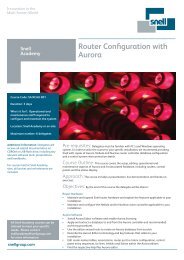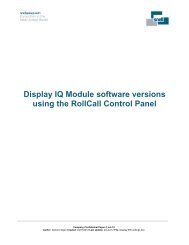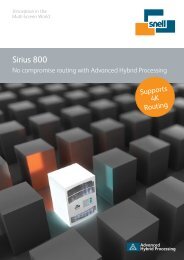Brochure - Sirius 600 Series - Snell
Brochure - Sirius 600 Series - Snell
Brochure - Sirius 600 Series - Snell
You also want an ePaper? Increase the reach of your titles
YUMPU automatically turns print PDFs into web optimized ePapers that Google loves.
Innovation in the<br />
Multi-Screen World<br />
Design Features<br />
<strong>Sirius</strong> <strong>600</strong> has many of the features<br />
associated with <strong>Snell</strong>’s hardware<br />
products, giving it a robustness and<br />
ease of maintenance essential in critical<br />
signal applications. All modules are ‘hotpluggable’,<br />
with surge suppression circuitry<br />
and phased power-up allowing quick and<br />
safe module swapping, this is further<br />
aided by the retention of crosspoint and<br />
configuration data in non-volatile control<br />
card memory.<br />
If dual control cards are fitted; crosspoint,<br />
configuration and database information<br />
is synchronized between the two cards.<br />
Changeover is automatic in the event of<br />
failure, and the tri-state buffering of all<br />
control signals ensures that changeover is<br />
also transparent to both the internal and<br />
any external systems.<br />
All signals inside the frame are routed point<br />
to point, using discrete buffering, thereby<br />
maintaining signal integrity and quality.<br />
This approach allows the router to be part<br />
equipped or “partitioned” with no loss of<br />
functionality. All frames are designed with<br />
3G capability, and can be upgraded to<br />
3G by simply equipping with 3G capable<br />
crosspoints and I/O cards.<br />
SDI video cards are available as two<br />
different options. Fully featured cards<br />
route 3G, HD, SD and ASI. Reclocking all<br />
these signals is standard on all frames, with<br />
the option to bypass if required for nonstandard<br />
data rates. Alternatively, an SD/<br />
ASI only option is available for applications<br />
where cost is a premium concern and HD<br />
capability not essential. Upgrade to HD or<br />
3G in future is simply a case of replacing<br />
these cards – no frame or configuration<br />
changes are required. This allows the user<br />
to select the most cost effective solution<br />
for their requirements using the best<br />
combination of input and output modules<br />
for their system.<br />
The <strong>Sirius</strong> video router will operate in<br />
a mixed standard environment. 525,<br />
625 and HD tri level references can be<br />
supplied to the frame, ensuring SMPTE<br />
compliant switching between sources of<br />
the same standards. Clean switching of<br />
audio requires a valid AES reference. The<br />
<strong>Sirius</strong> audio router is designed to work with<br />
mixed stereo and mono channels, where<br />
the necessary combining and switching<br />
is applied at both the input and output<br />
stages, for both the analog and digital<br />
formats providing an AES reference is<br />
supplied to the fame. The audio signal<br />
mode of each channel may either be stored<br />
in the database, or configured dynamically<br />
from a standard master control panel.<br />
Physical<br />
Logical<br />
Master <strong>Sirius</strong> frame with control module configured for 1 level<br />
of 128 x 128 and 4 level database<br />
128 x 128 mixed SDV / analog<br />
Slave <strong>Sirius</strong> frame with interface card configured for 2 levels of<br />
64 x 64<br />
64 x 64 balanced AES<br />
64 x 64 balanced AES<br />
Freeway frame, no control card, 2 crosspoint cards, set to be<br />
level 4<br />
64 port RS422 64 port RS422<br />
Example Multi-Level System


